Speed and efficiency are key to securing contracts and establishing long-term relationships. Whether you’re a project owner, general contractor, or subcontractor, you need a centralized system to handle prompt communication, assign tasks, and monitor progress.
This guide will explore Downtobid to determine what makes it the best construction bid management software and why you should try it.
Note: If you want to send personalized invites in minutes to relevant subs, try Downtobid. Our software breaksdown project plans using AI, gives you 100% scope coverage, and automatically sends out bid invites with sub names as well as relevant project information. Sign up for a demo of our software today.
Key Takeaways
- Downtobid's AI analyzes plans and creates personalized bid invites in minutes.
- AI matches bid packages with qualified local subcontractors automatically.
- Centralized platform eliminates manual document tracking and streamlines communication.
- Subcontractors access relevant drawings without creating accounts through optimized planrooms.
- AI-driven approach increases engagement 30% over traditional generic bidding platforms.
Our Testing Process
We evaluated 15+ AI bidding platforms using identical project files from mixed-use development. Each tool was reviewed based on plan analysis accuracy, subcontractor matching quality, ease of use, and time savings.
We develop Downtobid, which means we think it is great. But we also subscribed to every competitor here for six months of hands-on testing. We needed to know where we actually stand, not where we think we stand. These rankings reflect performance data from identical test projects.
1. Downtobid - Best Overall

Downtobid is a construction bid management software and AI copilot for pre-construction and estimating teams: useful to commercial, general contractors, and commercial subcontractors.
Our tool uses AI to analyze construction plans, identify scope items, and automatically match qualified local subcontractors for personalized bid invitations.
For Commercial General Contractors
- Estimators use it to enhance page turn, preventing missed scope (AI checks for all major trades and writes a brief summary)
- The AI Copilot then suggests the appropriate bid packages and matches this against the list of qualified , local subcontractors
- The AI copilot includes the detailed scope of work / sheets to the invitation to bid, ensuring that there are less scope gaps during the preconstruction phase
For Trade Contractors
- Estimating teams can now evaluate 100s of more opportunities at once
- The AI copilot scans through every plan set / bid invite that you receive and detects for scope that’s related to your trade
- If it fits your project wheelhouse, it automatically adds it to a bid board/calendar with all the key details automatically added (deadline, GC, etc)
- Analytics for win/loss
Now that we know what Downtobid is, let’s look at why it’s a unique platform helping transform the construction industry.
Remarkable Key Features of Downtobid
Some of the amazing features in the bid management platform are useful to General Contractors and Contractors, helping streamline their projects, improve communication, and expose them to unlimited opportunities. This includes:
AI Co-Pilot For Preconstruction Teams
With AI gaining traction in the software industry, Downtobid has managed to incorporate the cutting-edge technology into its platform. The AI automation process helps to review the bid packages to determine completeness and accuracy. The feature alone is priceless as it saves you time of going through all the documents manually.
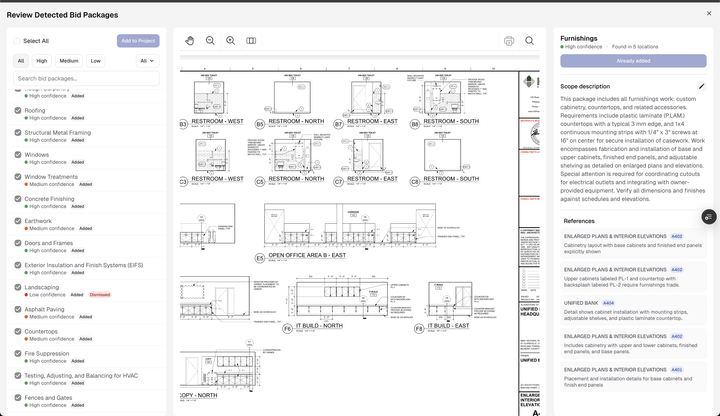
Even with a team to help you review all the project documents, it’s easy to miss critical details that derail the entire construction bid process. You’d also incur extra costs to outsource this task. Downtobid’s AI is fast and accurate, capable of going through hundreds of documents and checking for errors and completeness. You'll have this feature without incurring extra costs.
The AI doesn’t stop there. It also helps to match bid packages to subcontractors. Doing so helps contractors connect with the right subs to ensure proper coverage and prevent scope gaps. Contractors don’t need to go use a template for bid invitation, and go through the evaluation process manually anymore to find the right subcontractor.
Create Bid Invites in Minutes
With Downtobid, you can turn your plans and specs into bid invites as well as scope sheets in minutes. All you need to do is upload your documents, and the bid management platform does the rest.
If that’s not impressive enough, the platform creates personalized invites, helping you establish a genuine connection with contractors. Instead of sending a generic bid invitation that feels like a job interview, Downtobid includes the contractor’s names to make it feel personal and intimate.
This personal touch dramatically increases the number of subs responses to bid invitations compared to boring, standard template emails.
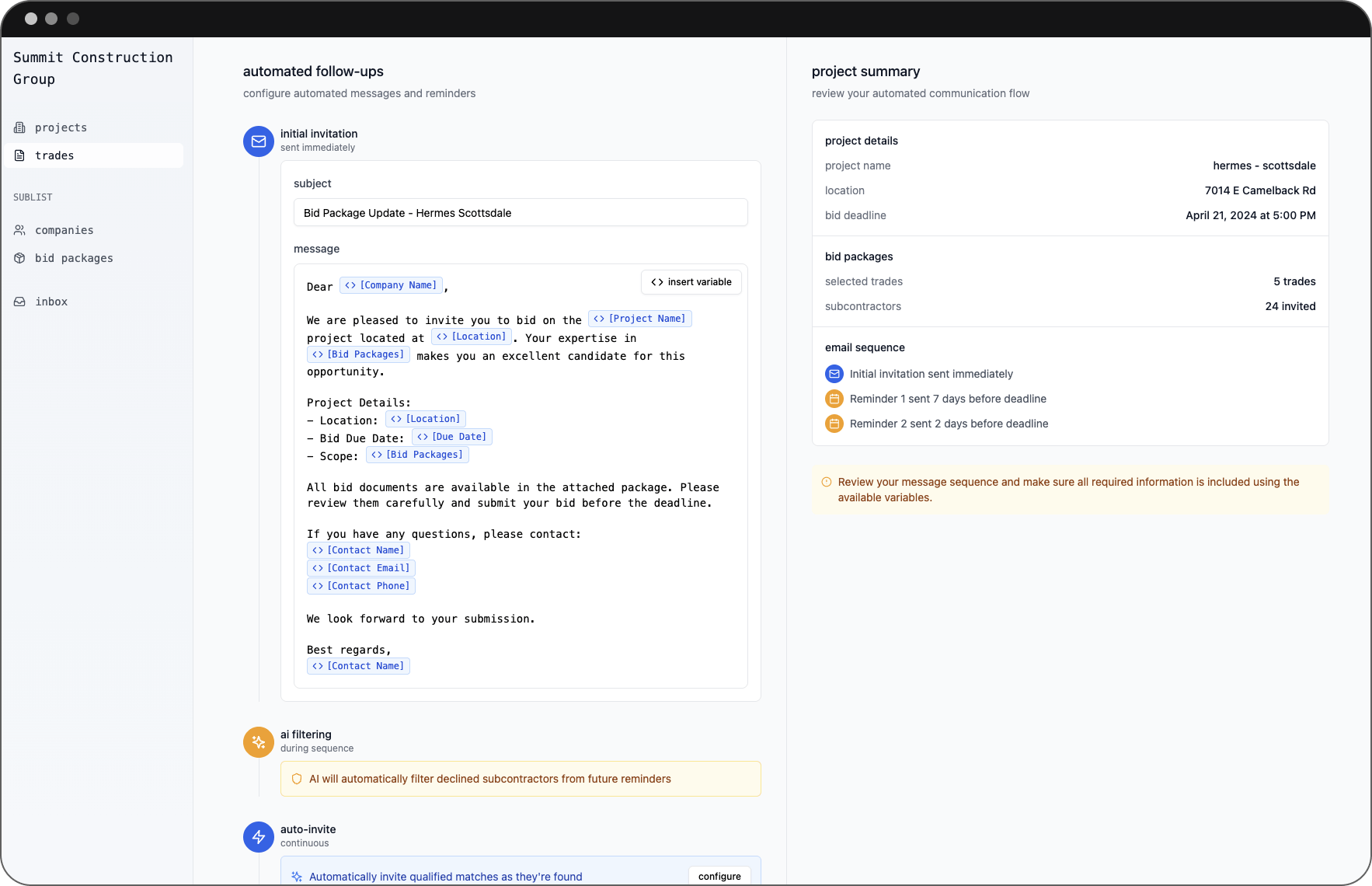
You can compare the features of other bid invitation software like e-Builder vs Procore and Downtobid here.
How Downtobid Works
First, click here to get started.
You'll be brought to a page where you can sign up for a demo, then enter your company details.
We will walk you through how to upload your project plans.
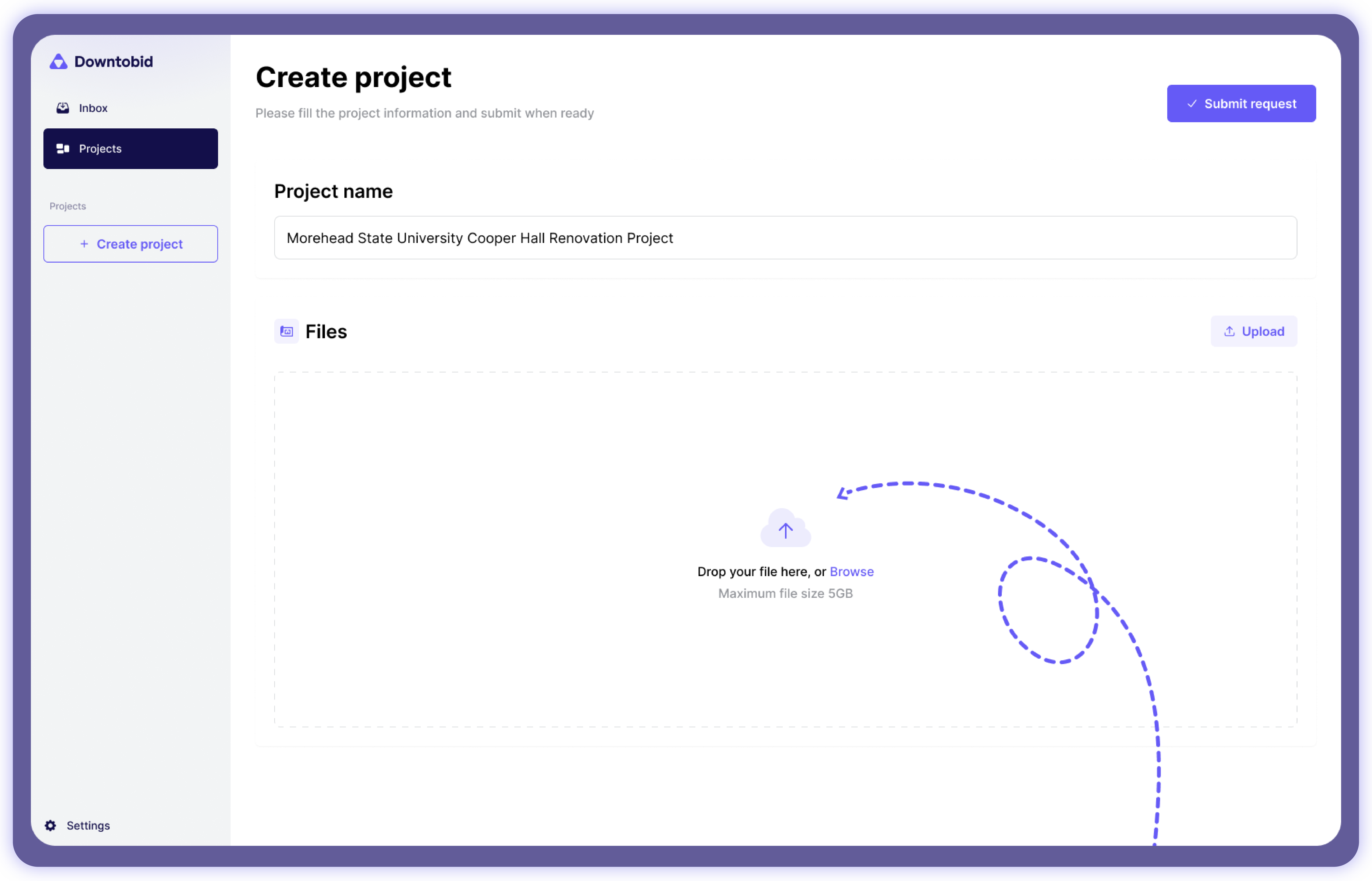
Upload your project plans and let AI do the rest.
The AI then goes through each page of your plan set and analyzes it for scope and creates the bid packages. This step takes about 10-30 minutes depending on the complexity of your project. Once it’s done, you should receive an email.
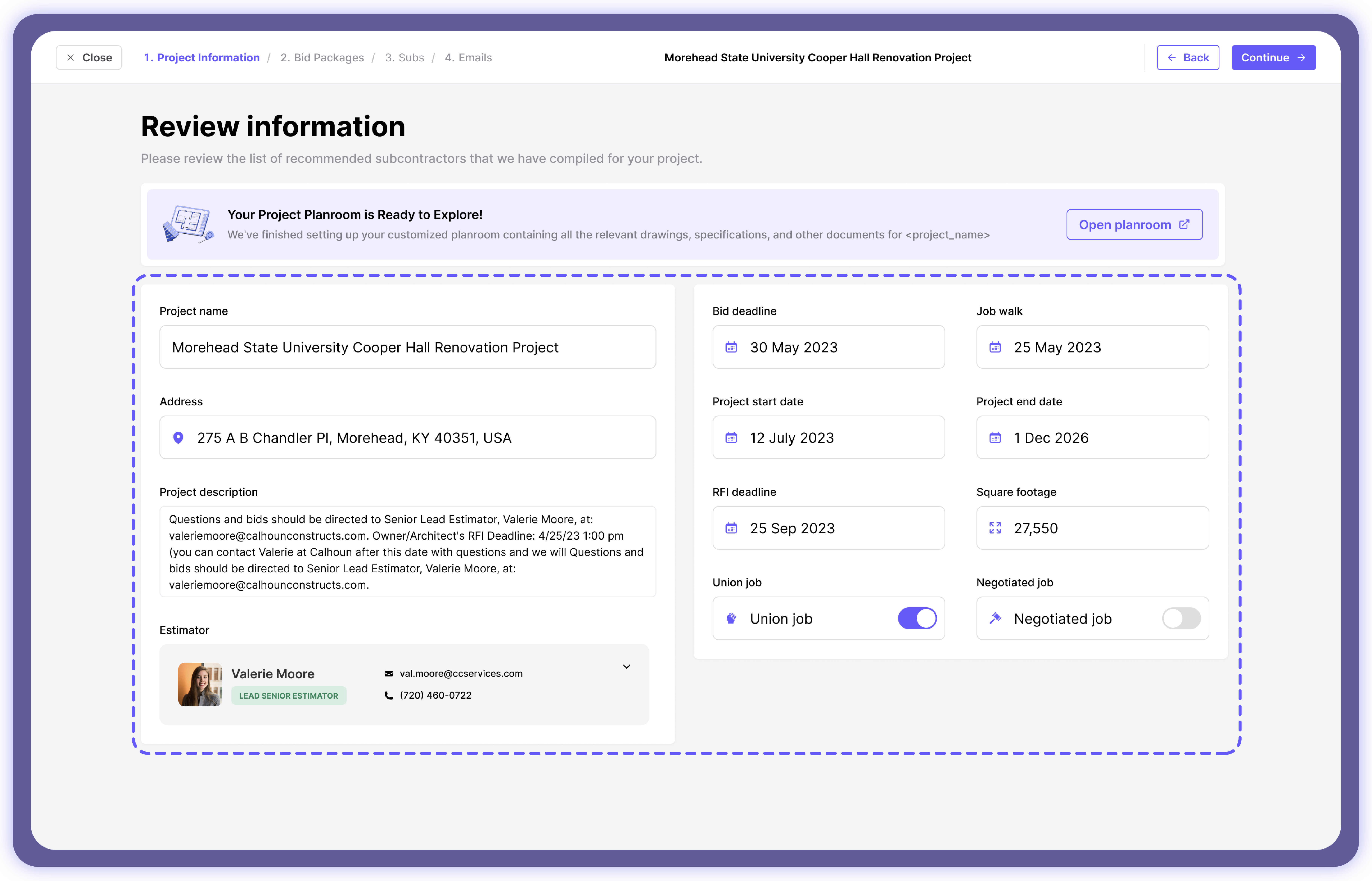
Upon logging in, you should see a full list of all the bid packages the AI copilot created. For each page, it will generate a simple scope sheet that covers:
- an overall description of the bid package
- each instance of where it’s detected scope in the plans
- a list of recommended local, qualified subs that you can invite.
As always, if you’re a GC with your own list, you can choose invite your own subs. Otherwise, you can use Downtobid's subcontractor network.
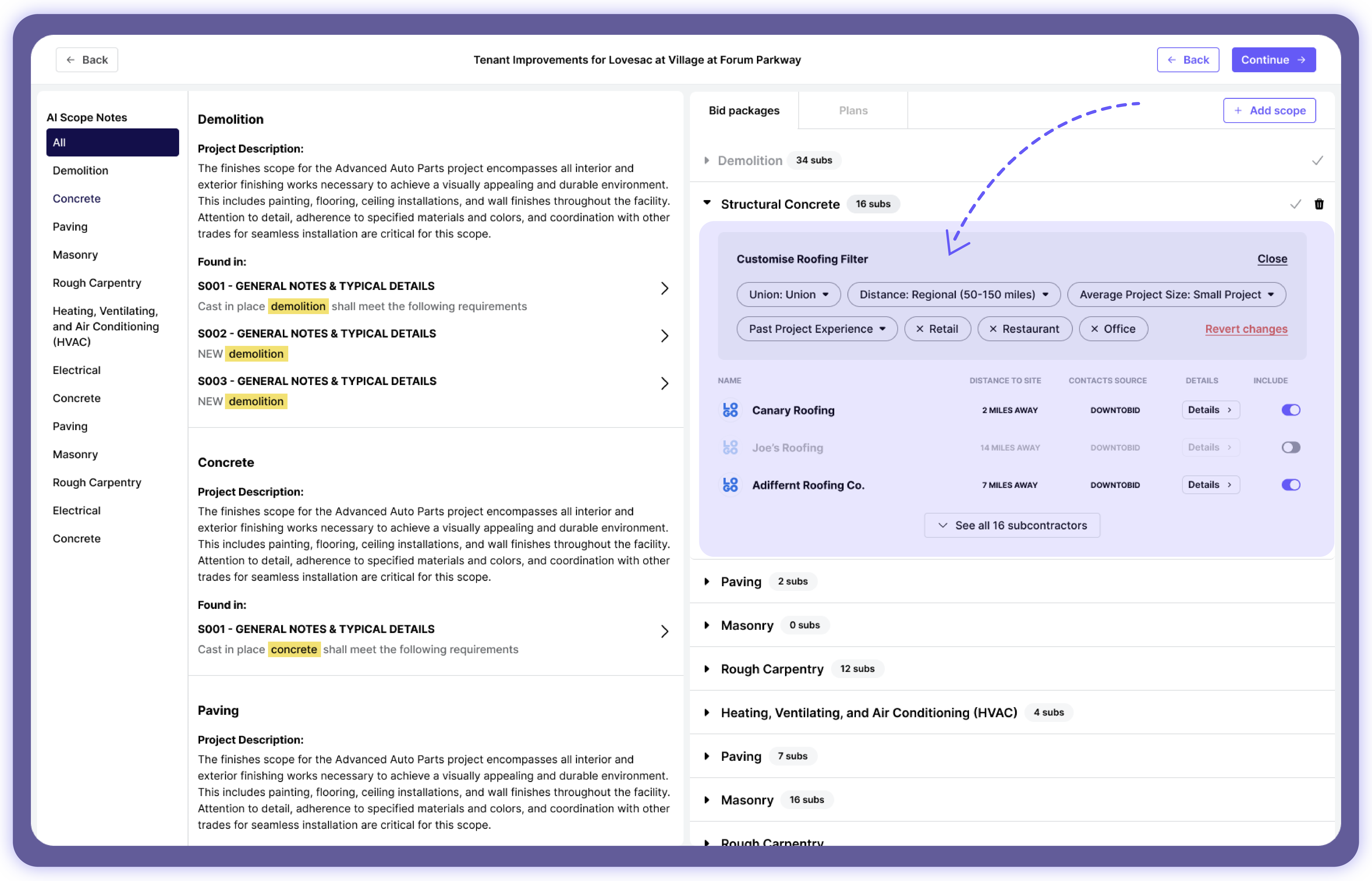
In addition, the AI automatically creates a suggested bidding schedule to send out your ITBs at optimal times. These ITBs include personalized details and a high-level scope summary so substitutes can quickly determine if the project matches their capabilities, without needing to search through detailed plans. Any necessary follow-ups are scheduled automatically by the system, with the timing and frequency adjusted based on the nearing proposal deadline.
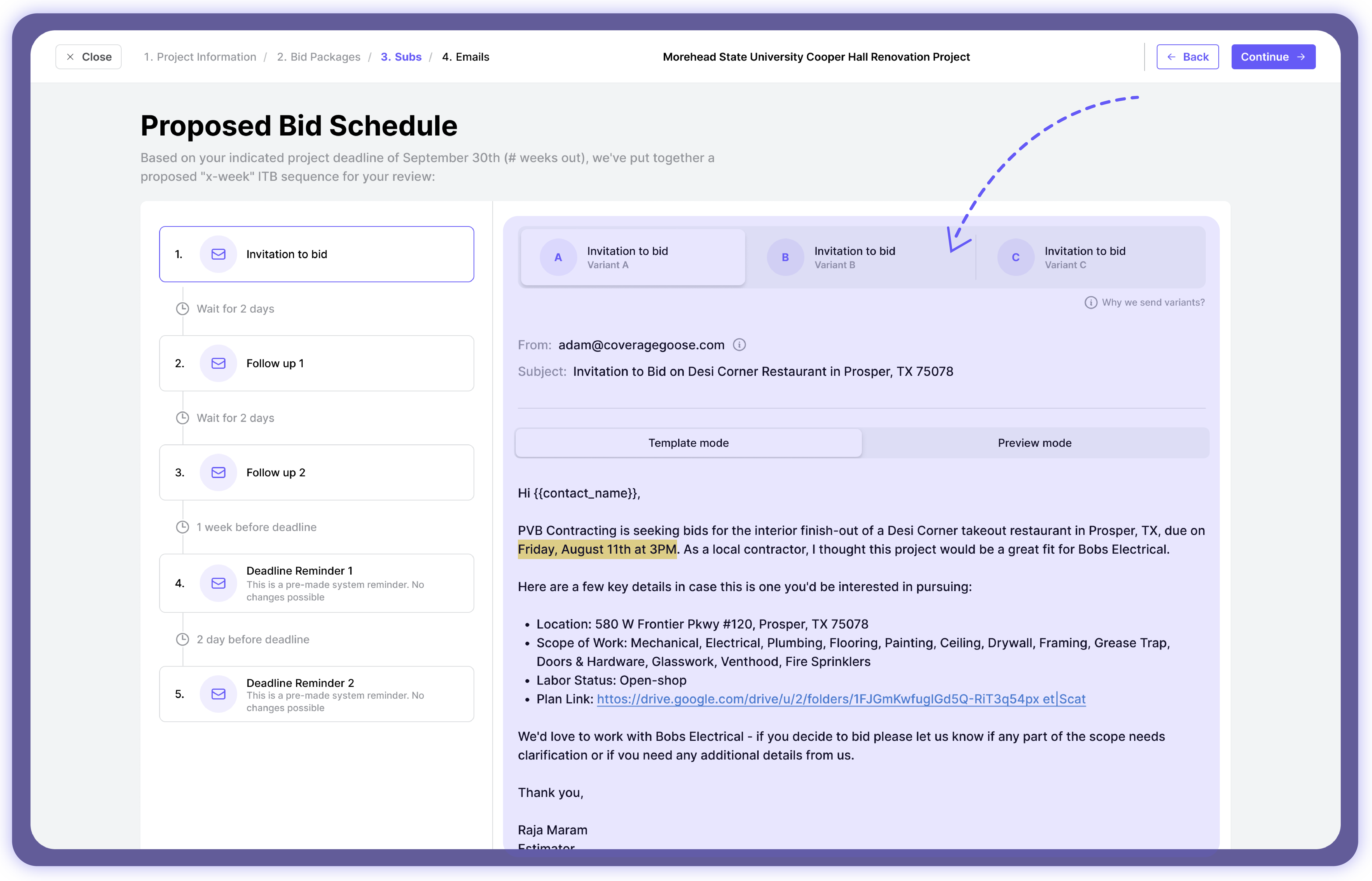
The planroom was designed to be easily accessible for subcontractors without needing to create an account. Subcontractors can quickly view only the drawings relevant to their scope of work. The fast performance and automatic splitting of sheets simplifies the process for them to qualify jobs.
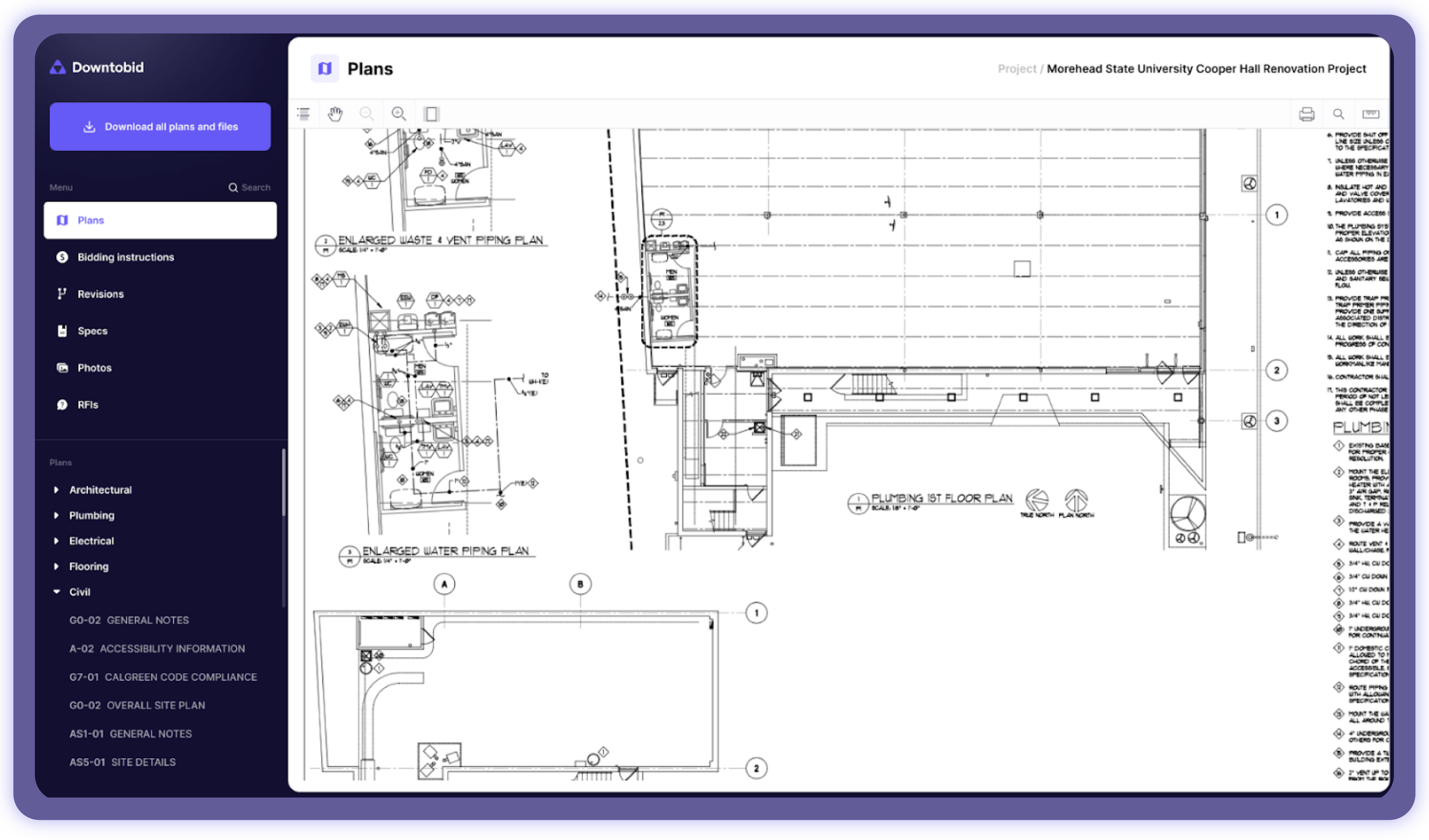
Our streamlined process, without the use of bidding intent buttons, receives significantly more engagement on average - around 30% more responses. Rather than rely on buttons, our AI reviews each replie and Planroom activity to determine a subcontractor's bidding intent and interest level. This allows us to automatically calculate more accurate coverage metrics based on meaningful interactions within the platform.

Lastly, all emails are forwarded to your email. That way you don’t ever have to leave your inbox just to respond to any emails.
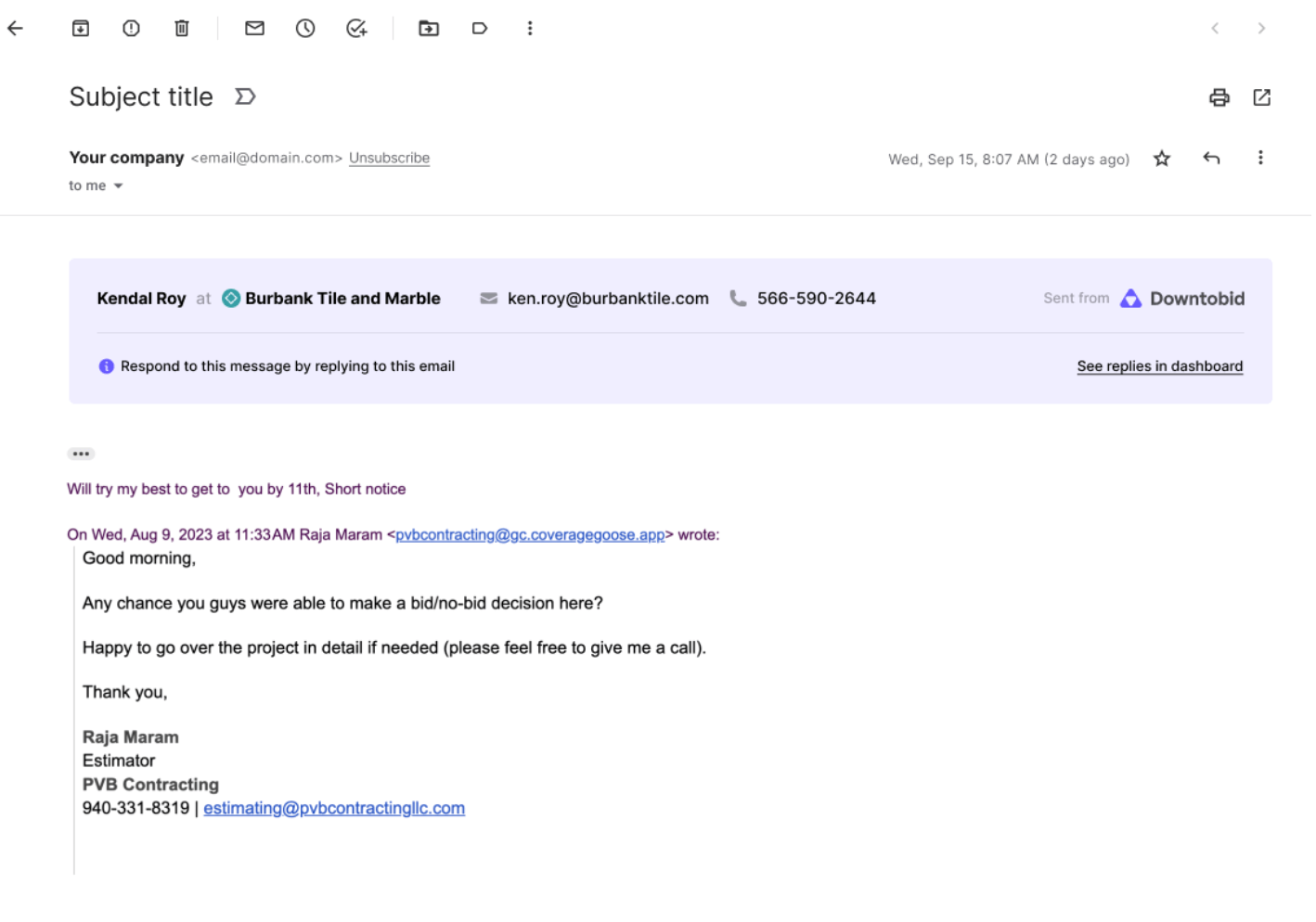
You can differentiate between other bidding softwares in our comparison of SmartBid and Downtobid.
Centralized Platform
With so many people and paperwork involved in the construction bidding process, it’s hard to keep up with every document and everyone. Downtobid offers a centralized system, putting everything you need in one place.
With everything done electronically and within the same platform, it becomes easy to track all the bid documents and paperwork involved. You won’t need to dig through countless folders in your office to find one document.
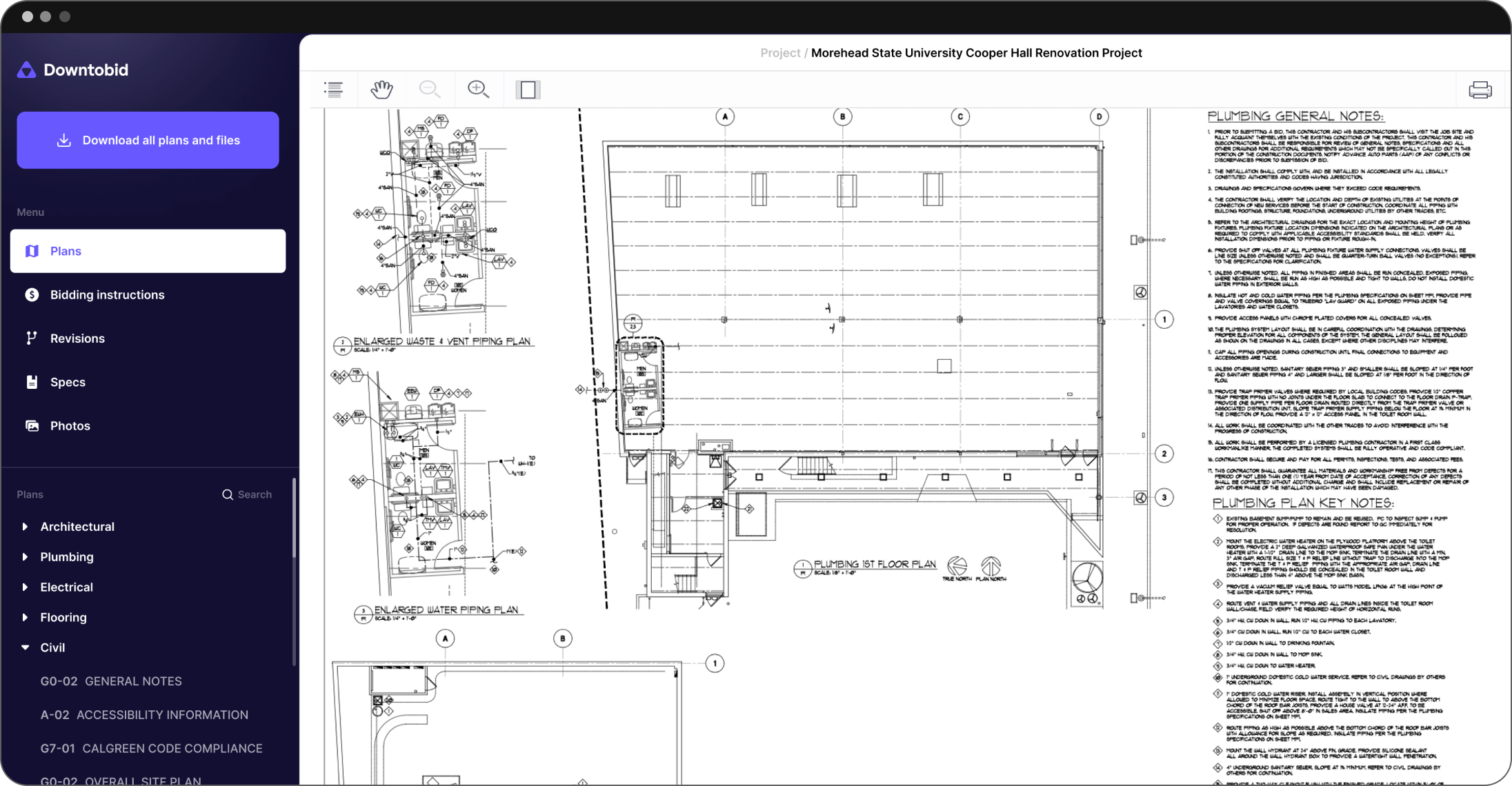
Downtobid has streamlined communication, making it easy for parties involved to share information, project updates, and clarifications on the go.
Finally, Downtobid has ITBs drafted that you can use right away. The platform populates the ITB draft with the relevant details, like the contractor’s names, trade expertise, and project history. This feature helps you create ITBs quickly without needing to write them yourself.
Verified Subcontractor Network - No Outdated Contacts
One of the biggest frustrations with traditional bid platforms is outdated data. Building Connected and Construct Connect rely on subcontractors to self-update their profiles, leading to dead emails, inactive companies, and contractors who've switched trades or moved companies.
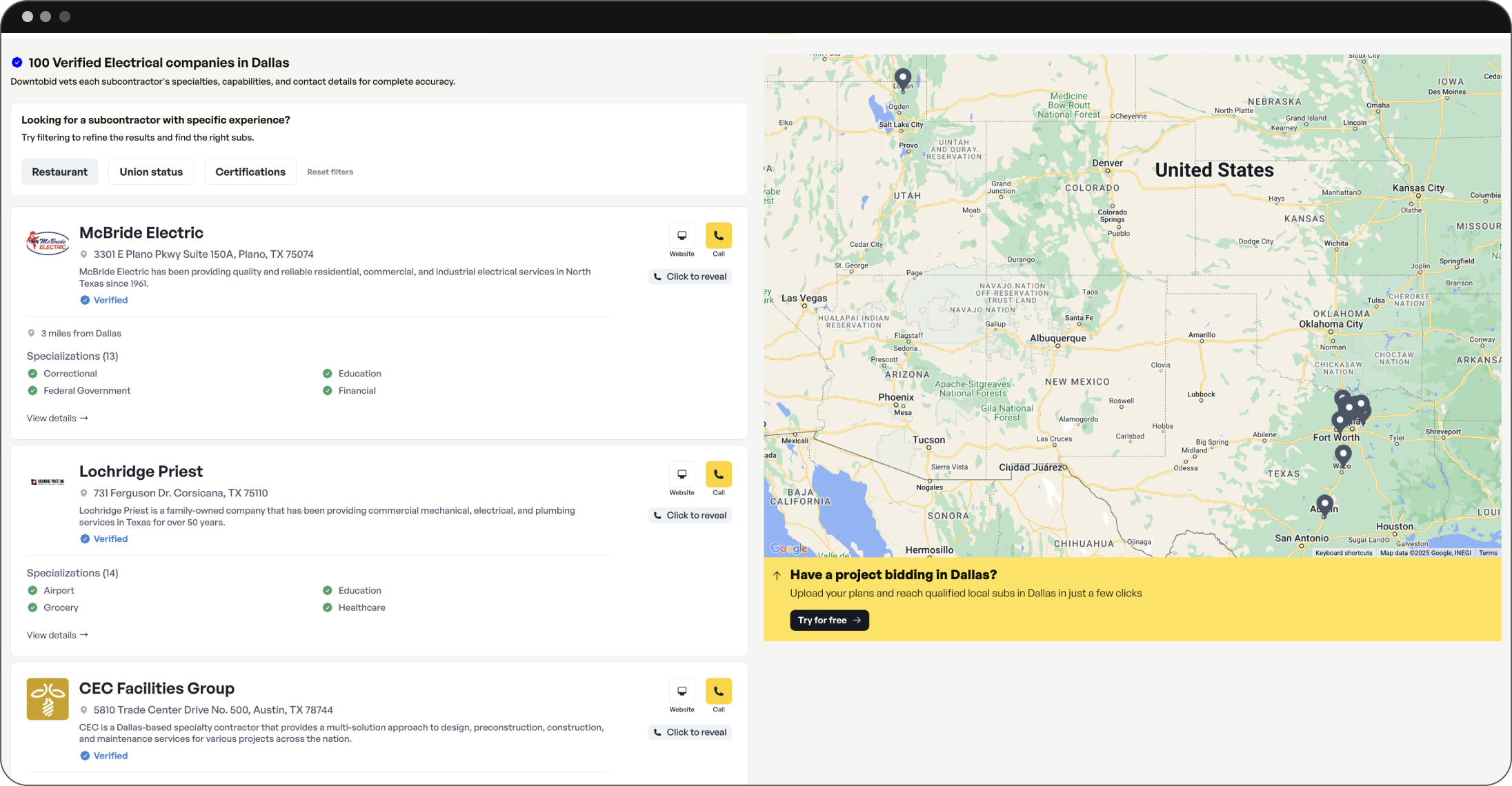
Downtobid solves this with our comprehensive verification process:
Multi-Point Data Verification
We don't rely on self-reported information. Our system automatically:
- Web-scrapes company websites to verify current services, location, and contact information
- Uses machine learning to confirm trade specializations based on project portfolios and website content
- Cross-references business licenses and insurance status
- Validates email addresses and phone numbers through direct outreach
Direct Decision-Maker Contacts
Generic emails like "info@contractor.com" get ignored. We identify and reach out to actual estimators and project managers at each company, ensuring your ITBs reach the people who make bidding decisions.
Continuous Data Refresh
Unlike static databases, we continuously update our network through:
- Automated quarterly verification sweeps
- Real-time engagement tracking from bid responses
- Manual verification when contractors don't respond to multiple projects
This verification process is why Downtobid users see 30% higher response rates compared to traditional platforms. You're not wasting time on dead leads or generic email blasts - every contact in our 57,000+ database is verified and current.
Features At A Glance
- AI plan analysis identifies scope in 10-30 minutes
- 57,000+ pre-qualified subcontractor database
- Personalized ITBs with contractor names and project details
- Automated follow-up scheduling based on bid deadlines
- Real-time engagement tracking and coverage metrics
Downtobid is helping to simplify the construction procurement process by centralizing everything. The use of AI helps to match contractors to suitable projects and analyze the bid documents. It helps clients turn their plans and designs into ITBs or RFPs within minutes.
2. BuildingConnected - Best for Enterprise Integration

Provides comprehensive bid management through Autodesk's construction ecosystem, offering broad integrations with design and project management tools.
BuildingConnected leverages its massive network of over 1 million trade contractors and integrates seamlessly with Autodesk and Procore platforms. The platform works well for large-scale projects requiring extensive collaboration between multiple stakeholders and departments.
However, the platform suffers from significant data quality issues. Because it allows anyone to create accounts, the database contains outdated contacts, duplicate entries, and contractors who are no longer active. Users frequently report reaching out to contacts who've moved companies or left the industry altogether.
Key Features:
- Massive database of 1 million+ contractors
- Deep integrations with Autodesk and collaboration tools
- Prequalification modules for risk management
- Enterprise-level collaboration capabilities
- Unlimited users and file sharing
Pricing: Contact for pricing (typically higher cost for smaller teams)
Best For: Large contractors already using Autodesk ecosystem who need enterprise integrations
Reddit User Feedback: "The main issue with BuildingConnected is that they sold to Autodesk... They rely on subcontractors to manage their own data. If someone's contact is out of date, I can't change it. I can't tell you how many times I have to follow up only to find out that they're literally DEAD."
Pros:
- Largest network in the industry
- Strong integration with Autodesk tools
- Good for multi-state or large-scale projects
- Enterprise-grade features and security
Cons:
- Outdated, self-managed subcontractor profiles
- Generic, non-personalized ITBs
- Complex interface can feel impersonal
- Data quality issues with inactive contacts
3. PlanHub - Best for Marketplace Discovery
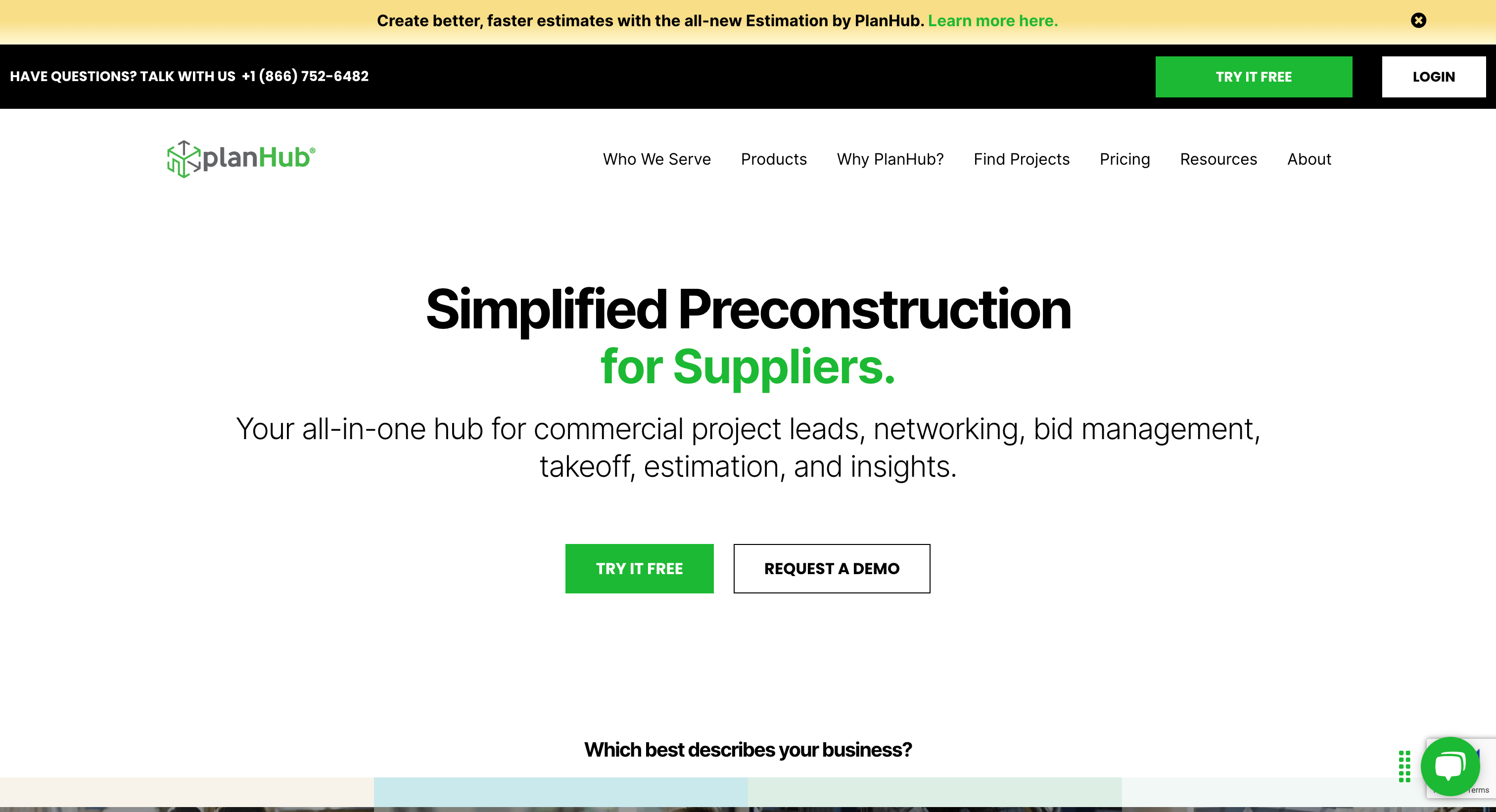
Operates as a marketplace where subcontractors actively search for projects while general contractors post opportunities with automated ITB distribution.
PlanHub takes a marketplace approach where subcontractors proactively look for work rather than passively receiving invitations. This creates more engaged bidders since subs are actively seeking projects, potentially leading to more competitive bidding.
However, the platform has significant accessibility issues. Subcontractors must create accounts and often pay subscription fees ($1,200-$3,300 annually) to access full project details, including GC contact information. This paywall approach frustrates many subs and can reduce participation from quality contractors.
Key Features:
- Free posting for general contractors
- Large network with active subcontractor participation
- Basic bid activity tracking and document sharing
- Digital planroom with file organization
- Geographic and trade-based filtering
You can compare PlanHub to Downtobid here.
Pricing: Free for GCs, but subs pay $1,200-$3,300/year for full access
Best For: GCs who want free exposure to actively engaged subcontractors
Reddit User Feedback: "I can't stand them. Usually when I get [PlanHub] invites I contact the GC directly. Their pricing is ridiculous." Another user: "I have the word 'planhub' blocked in my email."
Pros:
- Completely free for general contractors
- Active subcontractor participation
- Marketplace approach increases competition
- Wide geographic coverage
Cons:
- Subcontractor paywalls reduce participation
- Generic ITB blasts to thousands at once
- Forced account creation frustrates subs
- Limited personalization in outreach
4. Procore - Best for Existing Procore Users

Handles bid invitations within Procore's comprehensive construction management platform, providing seamless integration from bidding through project completion.
If you're already using Procore for project management, their bid module integrates seamlessly with existing workflows. You can create ITBs that automatically pull project information, drawings, and specifications from your Procore setup, eliminating duplicate data entry.
However, Procore's bid management lacks customization and automation. The platform sends generic ITBs without personalization options and relies on low-engagement "Yes/No/Undecided" bidding intent buttons. The database also suffers from self-updated profiles with accuracy issues similar to BuildingConnected.
Key Features:
- Complete integration with Procore project management platform
- Automated ITB creation from existing project data
- Subcontractor filtering by trade, location, and certifications
- Bid comparison and analysis tools
- Seamless transition to project execution workflows
Pricing: Part of Procore suite, (requires existing Procore subscription). Learn more about the pricing here.
Best For: Large contractors already using Procore who want integrated workflows
Pros:
- Seamless integration eliminates data transfer issues
- Enterprise-grade security and compliance
- Strong reporting and analytics capabilities
- Established platform with proven reliability
Cons:
- Expensive and requires full Procore subscription
- Lacks ITB customization and personalization
- Generic invitations without automation features
- Database relies on self-updated, often outdated profiles
These disadvantages often not make Procore worth it with its high price tag.
5. ConstructConnect - Best for Maximum Network Reach
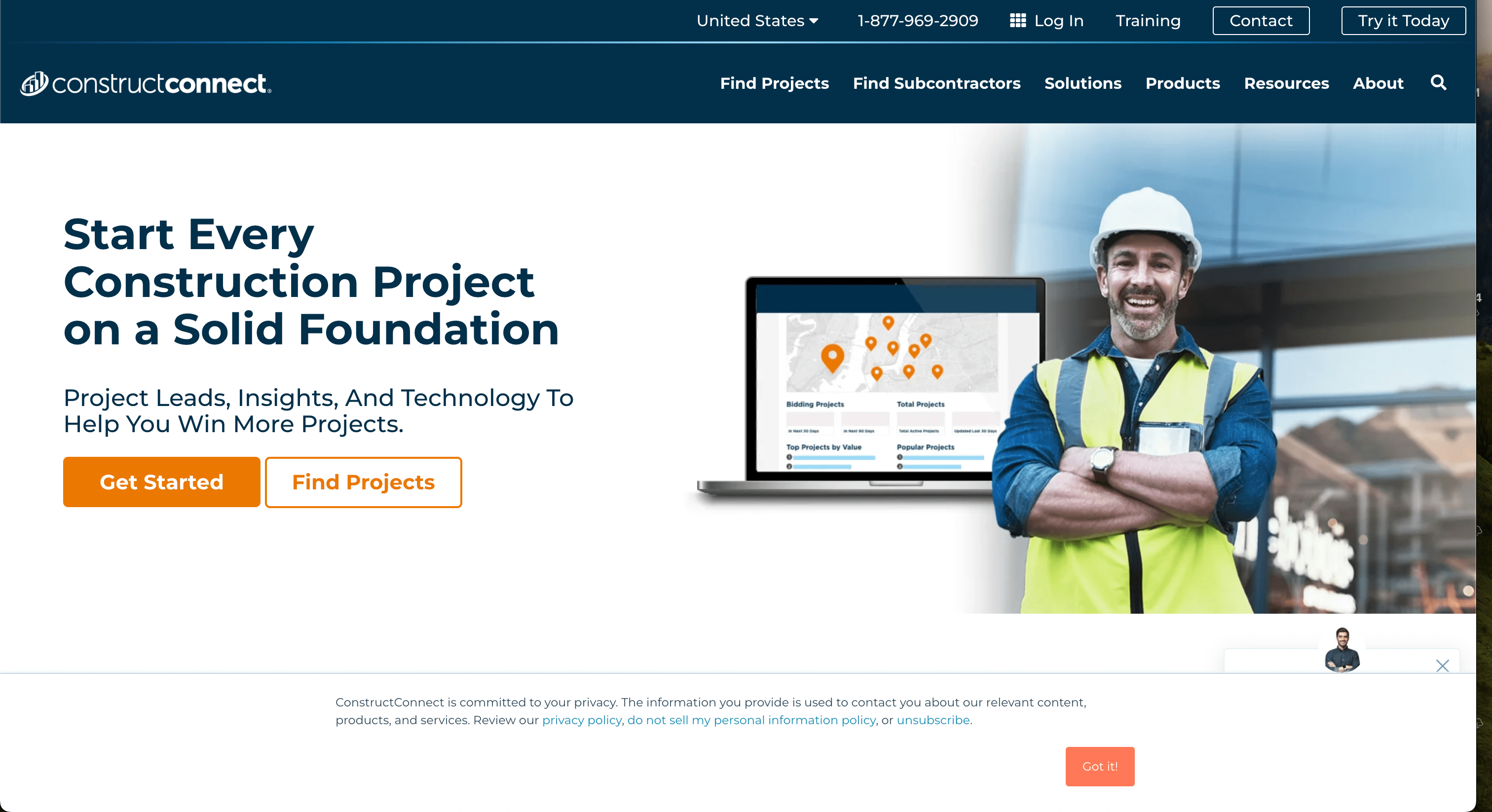
Provides access to the largest construction network with comprehensive market intelligence and extensive subcontractor database coverage.
ConstructConnect boasts 100,000+ bidders nationwide and covers 400+ metropolitan areas, making it appealing for contractors working across multiple regions. The platform acquired iSqFt and SmartBid to build this extensive network.
However, ConstructConnect encourages a "spray and pray" approach, sending mass invitations to thousands of subcontractors without personalization. The large database suffers from the same data quality issues as other platforms - self-updated profiles lead to outdated contacts, mismapped trades, and inactive listings.
Key Features:
- Largest network with 100,000+ bidders
- Coverage in 400+ metropolitan areas
- Prequalification modules and risk management tools
- Market intelligence and project tracking
- Mass ITB distribution capabilities
Pricing: $3,600/year for Bid Management package
Best For: Large contractors needing maximum geographic coverage
Pros:
- Largest subcontractor network available
- Extensive geographic coverage
- Comprehensive prequalification tools
- Market intelligence and analytics
Cons:
Here are some disadvantages for why Construct Connect may not be worth it.
- Encourages mass "spray and pray" approach
- Self-updated profiles with data quality issues
- Generic ITBs without personalization
- Expensive annual commitment
- Complex prequalification can limit contractor participation
Pick The Tool That Suits You
The construction bidding landscape is shifting from "spray and pray" mass distribution toward personalized, targeted outreach. Platforms like Downtobid that focus on automation, personalization, and verified data are delivering measurably better results - with users reporting 30%+ higher response rates and dramatically reduced preparation time.
Traditional platforms offer broader networks but suffer from data quality issues and generic approaches that frustrate subcontractors. The choice comes down to whether you want maximum efficiency through AI automation (Downtobid) or maximum network size through established platforms (despite their limitations).
For most commercial contractors, the time savings and improved response rates from AI-powered personalization outweigh the benefits of larger but less engaged networks.
Frequently Asked Questions
What is Downtobid and who is it for?
Downtobid is an AI-powered construction bid management platform designed for general contractors and subcontractors in commercial construction. It assists in analyzing plans, breaking down scopes, matching qualified subs, and automating personalized bid invitations to boost bid accuracy and win rates.
How does Downtobid improve the preconstruction bidding process?
Downtobid’s AI copilot scans project plans for full scope coverage, extracts bid packages, and matches them with verified subcontractors. It automates sending detailed, personalized ITBs to subs, enhancing engagement and response rates by up to 30%, while reducing manual administrative work.
What are the key features of Downtobid?
Key features include AI-driven plan analysis, automatic customized bid invites, a centralized digital planroom that subs can access without accounts, smart bidding schedules with automated follow-ups, analytics for bid tracking, and an extensive verified database of subcontractors.
How user-friendly and accessible is Downtobid?
Designed with a clean, intuitive interface, Downtobid simplifies project uploads and bid creation with minimal training required. Subcontractors enjoy easy access to relevant drawings without creating accounts. Email integration consolidates communication to your inbox for seamless bid management across teams.